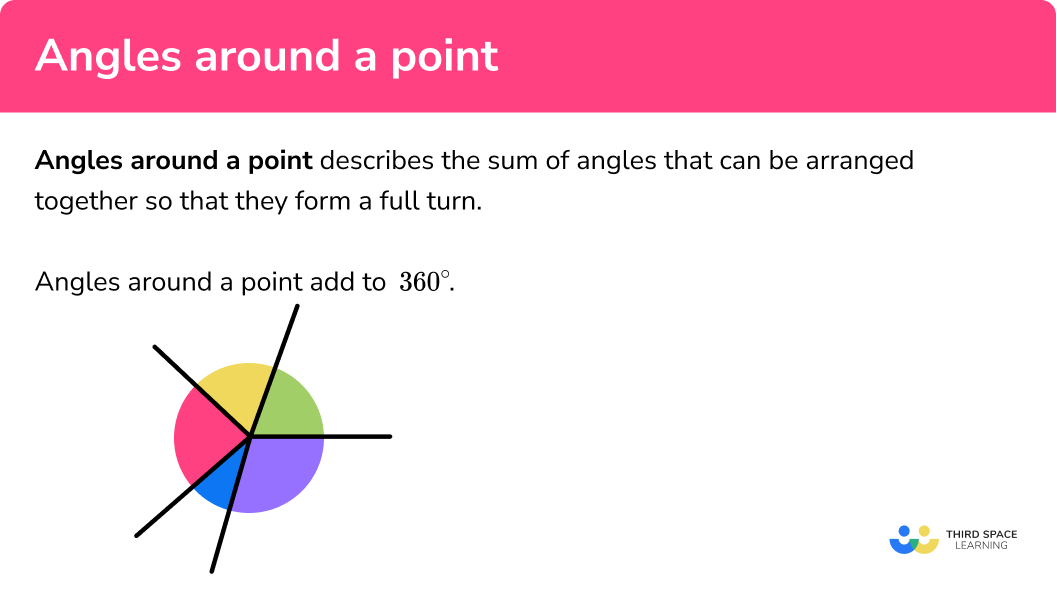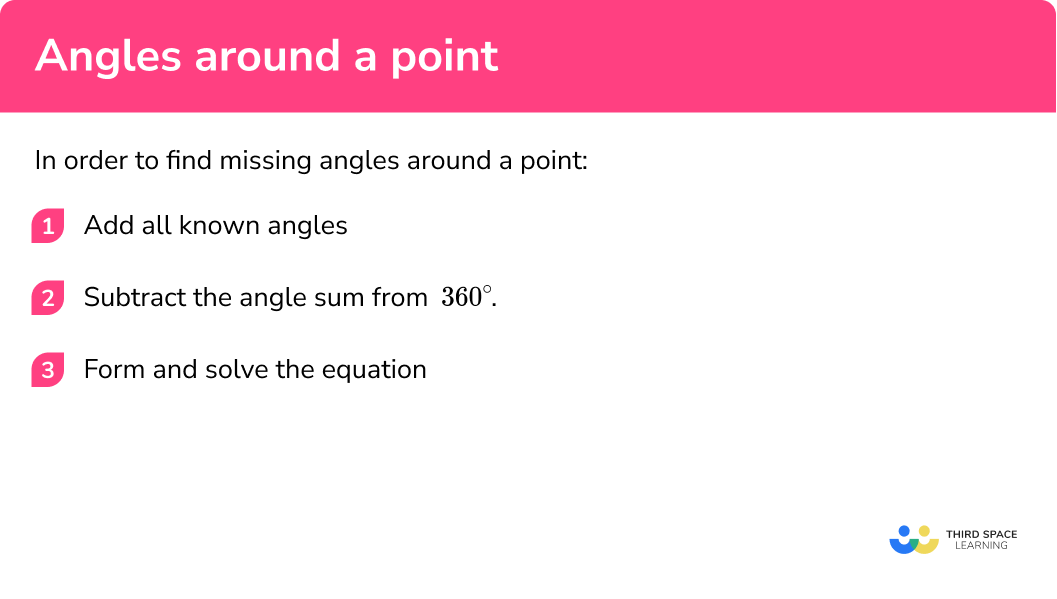One to one maths interventions built for KS4 success
Weekly online one to one GCSE maths revision lessons now available
In order to access this I need to be confident with:
Types of angles Angles on a straight line Collecting like terms Solving equations 2D shapesThis topic is relevant for:

Angles Around a Point
Here we will learn about angles around a point, including the sum of angles around a point, how to find missing angles, and using these angle facts to generate equations and solve problems.
There are also angles around a point worksheets based on Edexcel, AQA and OCR exam questions, along with further guidance on where to go next if you’re still stuck.
What are angles around a point?
Angles around a point describes the sum of angles that can be arranged together so that they form a full turn. Angles around a point add to
Let’s look at this visually and take the five angles below:
Rearranging these angles so that they meet at one point or vertex, we get:
The sum of the angles is
Angles around a point are applied to many problem solving style questions including properties of 2D shapes and 3D shapes including right angles, exterior angles, bearings, angles in parallel lines, pie charts, vertically opposite angles, and more.
What are angles around a point?

How to find missing angles around a point
In order to find missing angles around a point:
- Add all known angles.
- Subtract the angle sum from
360° . - Form and solve the equation.
How to find missing angles around a point


Angles around a point worksheet

Get your free angles around a point worksheet of 20+ questions and answers. Includes reasoning and applied questions.
DOWNLOAD FREE
Angles around a point worksheet

Get your free angles around a point worksheet of 20+ questions and answers. Includes reasoning and applied questions.
DOWNLOAD FREEAngles around a point examples
Example 1: reflex angles
The lines
- Add all known angles.
2Subtract the angle sum from
Example 2: multiple angles around a point
Calculate the size of angle
Add all known angles.
Subtract the angle sum from
Example 3: bearings
A ship is facing East. How far does the ship need to turn in the clockwise direction to face North West?
Add all known angles.
The angle between North West and North is a turn of
Subtract the angle sum from
Example 4: reflex angle inside a polygon
Add all known angles.
The sum of angles in a quadrilateral is equal to
The reflex angle at
Subtract the angle sum from
Example 5: forming and solving equations
The point
Add all known angles.
Form and solve the equation.
Angles around a point add to
We can check the solution by adding up the angles:
Example 6: angles in parallel lines
Calculate the exact value of
Add all known angles.
Using angle facts in parallel lines, we can state other angles in the diagram shown below:
This means we have a point surrounded by angles that we can add together:
So,
Or:
Form and solve the equation.
The vertically opposite angles of
Substituting
Common misconceptions
- Confusing the sum of angles around a point and angles on a straight line
The angle sum is remembered incorrectly as
- Incorrectly assuming the diagram is accurately drawn
The reflex angle in a diagram is incorrectly assumed to be double the other angle around a point.
E.g. in example 1
the reflex angle is calculated as
- Solving equations
There are many misconceptions around forming and solving equations. See the lesson on forming and solving equations for further information.
Step by step guide: Solving equations
- Using a protractor
When you are asked to calculate a missing angle, a common error is to use a protractor to measure the angle. When using angle facts to determine angles, diagrams are deliberately not drawn to scale unless the angle is
Related lessons
Angles around a point is part of our series of lessons to support revision on angle rules. You may find it helpful to start with the main angle rules lesson for a summary of what to expect, or use the step by step guides below for further detail on individual topics. Other lessons in this series include:
Practice angles around a point questions
1. Calculate the size of angle x .




2. Calculate the size of angle x .




3. The diagram below shows 3 points on an 8 -point compass.
Chris is standing at point O, facing North West. How far clockwise does he need to turn to face East?




The angle between North West and North is a turn of 45^{\circ} . The angle between North and East is equal to 90^{\circ} , so 45+90=135^{\circ} .
4. Calculate the size of angle BOF.




5. The point O is created by five lines meeting at one vertex.
Calculate the size of each angle.




6. By using angle facts, calculate the size of angle x .




Angles on a straight line: 180-95=85^{\circ}
Corresponding angles: 85^{\circ}
Angles on a straight line: 180-100=80^{\circ}
Angles in a triangle: 180-(85+80)=15^{\circ}
Angles around a point: 360-15=345^{\circ}
Angles around a point GCSE questions
1. Calculate the size of the angle y .
(2 marks)
90+97=187
(1)
360-187=173^{\circ}
(1)
2.
(a) Three regular hexagons are placed in the following format:
Show that each of the 6 triangles that make up one hexagon is an equilateral triangle.
(b) Calculate the size of angle x .
(6 marks)
a)
Regular hexagons have equal side lengths and equal angles
(1)
The regular hexagons tessellate so 360\div6=60^{\circ}
(1)
Alternate angles are the same at 60^{\circ}
(1)
All interior angles equal 60^{\circ}
(1)
b)
60+60=120
(1)
360-120=240^{\circ}
(1)
3. Tim is practicing using a compass. He takes 10 steps on a bearing of 180^{\circ} , followed by 10 steps at a bearing of 090^{\circ} . He then turns 200^{\circ} anticlockwise.
What bearing is he now facing?
(3 marks)
180^{\circ} is South, 090^{\circ} is East
(1)
200^{\circ} anticlockwise = 360-200=160^{\circ} clockwise
(1)
090+160=250^{\circ}
(1)
Learning checklist
You have now learned how to:
- Find unknown angles around a point
The next lessons are
Still stuck?
Prepare your KS4 students for maths GCSEs success with Third Space Learning. Weekly online one to one GCSE maths revision lessons delivered by expert maths tutors.

Find out more about our GCSE maths tuition programme.